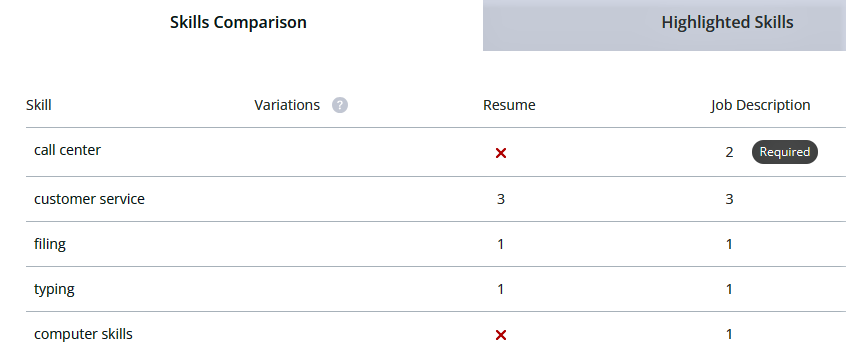If you’re unsure whether to write your resume in past tense or present tense, traditional advice sides with common sense. If you’re describing something in your past, use past tense. Managed, coded, designed, and marketed. If you’re describing something you’re still doing in your current job, use the present tense. Manage, code, design, and market.
While this sounds simple, in practice it can get a little more complicated.
Let’s take a look at exactly when you should use the present tense on your resume, when you should use the past tense, and when you can mix tenses.
Table of Contents
- When to use past tense on your resume
- When to use present tense on your resume
- When you can mix tenses on your resume
- Do tenses affect how applicant tracking systems read your resume?
- How to tailor your resume and get more job interviews
- Key takeaways
When to use past tense on your resume
Most of your resume should be written in the past tense. This is because you’re talking about jobs and projects you’ve already done.
Here are three places on your resume where you should use the past tense:
1) Work experience section
When listing the roles and responsibilities you held at previous jobs, always use the past tense to indicate that these are tasks you have completed.
Your work experience bullet points should look like this:
- Enhanced customer satisfaction by 25 percent by implementing a new feedback system.
- Increased quarterly sales by 15 percent through the development of new marketing strategies.
- Coordinated and hosted successful community outreach events that strengthened brand awareness.
Here’s an example of how past work experience should look on a resume:

2) Education section
In your education section, use the past tense to describe any notable achievements or activities you were involved in during your time in school or university.
For example:
- Served as the president of the student council.
- Organized a successful fundraising event as the treasurer of the college charity club.
- Published a well-received research paper on environmental conservation in the university journal.
3) Awards and achievements
Use the past tense to describe awards, recognitions, or certifications you have received in the past.
For example:
- Received the Employee of the Year award in 2021.
- Earned a certification in Advanced Project Management in 2019.
- Recognized as the Top Salesperson of the Quarter in Fall 2022.
When to use present tense on your resume
Some of your resume should be in the present tense, especially when mentioning tasks and responsibilities in your current job.
Here are three areas where you should use the present tense:
1) Current job responsibilities
When writing about your current job, use the present tense to show that you are actively engaged in those duties and responsibilities.
Your bullet points should look like this:
- Leading a team of professionals in optimizing product development.
- Implementing innovative marketing strategies to boost brand visibility.
- Collaborating with cross-functional teams to enhance project efficiency.
2) Resume headline
Your resume headline is a brief phrase that highlights your professional identity. It should appear at the top of your resume, right under your contact information.
Here are some examples of resume headlines that use the present tense:
- Experienced Project Manager Seeking New Opportunities.
- Dedicated Financial Analyst with a Proven Track Record.
- Dynamic Sales Leader Specializing in Market Growth.
3) Resume summary
Your resume summary is a brief statement that highlights your professional skills, experience, and achievements. It should appear right beneath your resume headline.
You should always use the present tense in your summary to show that you are currently working and ready to contribute your skills and knowledge to a prospective employer.
Here’s an example of a resume summary in the present tense:
“Experienced marketing professional with over 10 years of experience in developing and implementing innovative marketing strategies in the retail sector. Proven track record of increasing brand awareness and boosting sales. Adept at leading teams and managing multiple projects simultaneously.”
And here’s what a resume headline, a resume summary, and a resume skills section should look like when formatted:

When you can mix tenses on your resume
There’s really only one place on your resume where you can mix tenses – your current job.
When discussing your current job responsibilities, it’s not only acceptable but often necessary to use both past and present tenses. Here’s how:
Use the present tense for ongoing responsibilities
For tasks that are a regular part of your current job, use the present tense to indicate that these are responsibilities you fulfill on an ongoing basis. For instance:
- Managing a team of 10 individuals.
- Overseeing daily operations.
- Developing monthly reports.
Use past tense for completed projects
When listing projects or accomplishments that have been completed within the timeframe of your current job, use the past tense.
For example:
- Implemented a new software system that improved efficiency by 20 percent.
- Led a successful marketing campaign that increased brand awareness.
- Organized a company event attended by over 500 employees.
Below is an example of a resume work experience section that mixes tenses.
The first part describes the candidate’s current job responsibilities in the present tense, while the bullet points describe the candidate’s accomplishments in the past tense:

By mixing tenses in this way, you can create a more dynamic and accurate representation of your role.
Do NOT mix tenses within the bullet point section, or when describing your current job responsibilities.
Mixing tenses like this can create a jarring reading experience and may convey a lack of attention to detail, potentially undermining the credibility of your application.

Do tenses affect how applicant tracking systems read your resume?
Most large companies today use computer software called an applicant tracking system (ATS) to help them in the hiring process.
When you submit your resume it goes directly into an ATS database. Hiring managers then search through the database looking for suitable job candidates. They do this by typing keywords into the ATS search bar. These keywords are usually skills or job titles.
For example, if a hiring manager wants to find a candidate who has “data analysis” skills they would type that keyword into the ATS search bar. Resumes that contain the keyword “data analysis” will appear to the hiring manager for further review. Resumes without that keyword will remain in the database.
In the past, ATS only recognized exact matches. For example, if a recruiter was looking for a candidate with “management” experience but your resume only contained the words “manage” or “managed”, the ATS would not consider that a match.
However, after extensive testing and analysis of various applicant tracking systems (ATS), Jobscan has found that these systems have evolved to recognize variations of a word.
This means that a hiring manager who’s looking for a job candidate with “management” experience will also find resumes that include “manage”, “managed”, or even “manager”.
Thankfully, it’s not necessary to have the exact tense of a keyword on your resume anymore. This often made it difficult for job seekers to create a natural-sounding resume.
But this doesn’t mean you should just create one resume that you send out with every application. As we’ve seen, your resume still needs to contain relevant keywords in order to be found by hiring managers.
In other words, because of ATS, it’s crucial that you tailor your resume.
How to tailor your resume and get more job interviews
If you want to get more job interviews, you must tailor each resume for the job you’re applying for. This is because applicant tracking systems use keywords to filter the pool of applicants.
Where can you find these keywords? In the job description.
Carefully read the job description to identify the key skills, qualifications, and responsibilities mentioned. Make a list of these keywords, and incorporate them into your resume whenever possible.
Unfortunately, tailoring each resume is time-consuming. That’s why job seekers are turning to online tools to speed up the process.
Jobscan’s resume scanner can help you tailor your resumes in a fraction of the time it takes to do it manually. It works like this:
Step 1: Upload your resume into the scanner.
Step 2: Paste the job description into the scanner.
Step 3: Click the “scan” button.
You’ll then receive a Match Report. This report scores your resume and highlights the skills and keywords you should try to add to your resume so it can easily be found by a hiring manager.
Here’s a sample section of a Match Report for a customer service job:

You can see that the keyword “call center” should be added to your resume. If it’s not, you’re far less likely to get an interview.
In addition, if your resume has any searchability issues, the Match Report will point them out.

Remember, only one mistake on your resume can diminish your chances of getting noticed by a hiring manager.
By using the Jobscan resume scanner, you’ll increase your interview chances by 50%. Try it for free here.
If you’re building your resume from scratch, try our free resume builder. There are no hidden costs and it will allow you to create an ATS-compatible resume in no time!
Make your resume stand out and get noticed
Upload your resume to see what’s missing and get a free match rate.
View full results and optimize your resume
Key takeaways
- Use the past tense in your work experience section, your education section, and the section where you list your awards, recognitions, or certifications.
- Use the present tense in your resume headline, your resume summary, and when talking about your current job responsibilities.
- Mix your tenses when describing your current job. Use the present tense to list your ongoing responsibilities and the past tense to list your accomplishments.
More expert insights on this topic:



















